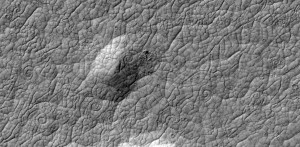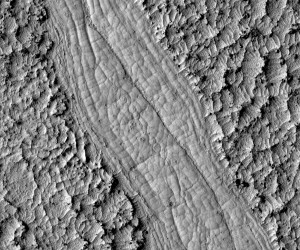
This image, with more than a dozen lava coils visible, shows an area in a volcanic region named Cerberus Palus that is about 500 meters wide. (Photo: NASA/JPL/University of Arizona)
An Arizona State University graduate student has discovered unique spiral patterns in solidified lava flows on the surface of Mars.
In a paper published in Science, Andrew Ryan describes the snail-like patterns as ranging in size from about one meter to 30 meters across.
While lava flows such as these have been found on the Big Island of Hawaii and near the Galapagos Rift on the Pacific Ocean floor, Ryan says they’ve never been detected on Mars before.
Ryan was originally doing research into possible interactions of lava flows with floods of water in the Elysium volcanic province located near the Mars equator.
Some of the features of this Martian volcanic region include what has been described as large slabs or plates of volcanic rock that look like the broken floes of pack ice that can be found in Earth’s Arctic Ocean.
For several years, scientists have theorized there was a frozen ocean in that region, and that the physical appearance of the volcanic plate’s chunks of ice floe may be caused by ice that lies beneath them.
It was these claims of ice that drew Ryan to focus his research on that area of Mars.

Newer lava lying between two older plates of rough, hardened lava was still hot and plastic enough to form coils and spirals when the plates slid past one another. This image shows an area about 360 meters wide in Cerberus Palus. (Photo: NASA/JPL/University of Arizona)
Ryan was fascinated by the terrain that lies between the plates and the high-centered polygonal patterns that were found there.
That led him to examine images of the region captured by the various Martian probes circling the planet.
After scrutinizing almost 100 images, Ryan determined that the various landforms, including the lava flow coils, that he saw were indeed volcanic and not ice related.
His findings confirmed what he and his colleagues had thought all along.
“This region is very close to the Martian equator and we don’t expect to find near-surface ice that close to the equator,” Ryan says.
As to how the lava flows coils themselves were formed, Ryan explains, “The coils form on flows where there’s a shear stress — where flows move past each other at different speeds or in different directions. Pieces of rubbery and plastic lava crust can either be peeled away and physically coiled up — or wrinkles in the lava’s thin crust can be twisted around.”
Once some numerical modeling has been done, Ryan says that it might be possible to learn a bit about the composition of the lava that formed the coils.
He also plans to do further research which he hopes will help determine the viscosity, or thickness, of the lava while it was solidifying and forming the coils.
Andrew Ryan joins us on this week’s radio edition of Science World to talk about his discovery, as well as the research and study he conducted to back-up his findings. Tune in (see right column for scheduled times) or check out the interview below.
[audio://blogs.voanews.com/science-world/files/2012/04/One-On-One-Andrew-Ryan-Lava-Coils-on-Mars.mp3|titles=One On One – Andrew Ryan – Lava Coils on Mars]
Other stories we cover on the “Science World” radio program this week include:
- India launches new observation satellite
- Study: Africa may have huge supplies of freshwater underground
- Experts say no danger from new case of mad cow disease
- WHO sees gains in fight against malaria but concerns remain
- HIV treatments may also work to help prevent initial infection
- First US commercial resupply mission to the ISS postponed
- Titanic director backs plan to mine precious metals from asteroids





















Comments are closed.